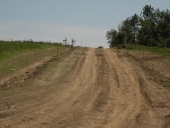
 1
1




 1
1




 1
1




Invasive plants are Earth's way of insisting we notice her medicines. Stephen Herrod Buhner
Everyone learns what works by learning what doesn't work. Stephen Herrod Buhner
 2
2




John Daley Bendigo, Australia The Enemy of progress is the hope of a perfect plan
Benefits of rainfall collection https://permies.com/t/88043/benefits-rainfall-collection
GOOD DEBT/ BAD DEBT https://permies.com/t/179218/mortgages-good-debt-bad-debt
 1
1




John Daley Bendigo, Australia The Enemy of progress is the hope of a perfect plan
Benefits of rainfall collection https://permies.com/t/88043/benefits-rainfall-collection
GOOD DEBT/ BAD DEBT https://permies.com/t/179218/mortgages-good-debt-bad-debt
 1
1




John C Daley wrote:This is an area of expertise for myself.
Basically if you study road building you will see what to do.
I recommend in Australia the following=
Geo fabric is great in a lot of cases but it not low priced
First layer of rock should be 40mm crushed rock, with no fines in it. Crushed rock with fines is called Crushed rock 40mm minus.
When its settled a bit , say 12 months add another layer of 20mm minus, crushed rock and out a roller or wackier over it.
This should be perfect.
A couple of extra tips;
Any decent truck driver should be able to spread the rock by fitting chains to the tailgate to limit how far the tail gate opens, then as he lifts the tipper and reverses backwards the rock will spread out and he has a solid surface to travel over.
If he lifts the load whilst sitting on sloppy mud, he may get bogged.
Also, if you are building anything, I suggest you get the 40mm laid first, then have the builders drive over it to attend to the construction and they will help compact it, not get bogged on the site and they will love you.
Then when its finished spread the 20mm.
The bigger rock will settle into the mud and create a stable base for the 20mm minus.
If you apply the 20mm minus first the mud and water will come through it and become a boggy mess again.
 1
1




John Daley Bendigo, Australia The Enemy of progress is the hope of a perfect plan
Benefits of rainfall collection https://permies.com/t/88043/benefits-rainfall-collection
GOOD DEBT/ BAD DEBT https://permies.com/t/179218/mortgages-good-debt-bad-debt
 1
1




 2
2








 4
4





|
Until you dig a hole, plant a tree, water it and make it survive, you haven't done a thing - Wangari Maathai
Homestead Pastured Poultry course
https://permies.com/wiki/364740/Homestead-Pastured-Poultry
|




